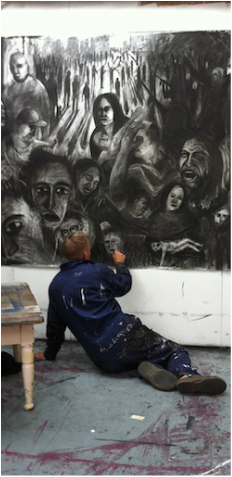Drawing techniques

Drawing is central to my art. I draw on many different levels, each with a different emphasis. My drawing practise includes sketchbooks, life studies, imaginative drawing and large-scale finished drawings, as well as the drawing that forms the essential structure of every piece of art I have ever made.
Large-scale Finished Drawings
Drawings are usually perceived as somehow inferior to paintings, but I believe this is principally because of market demands. I have always produced large-scale, highly finished drawings, and consider them to be every bit the equal to my paintings.
Some of these drawings have been based on specific ideas, but the best of them were driven into shape by an intense inner need. They begin by drawing abstract shapes in charcoal, and with great effort they evolve into complex and tightly composed narratives over a period of time.
Life Drawing
The term life drawing is traditionally associated with the figure, but for me it encompasses the whole visual arena of life. I draw from life to expand my visual vocabulary and keep my hand, eye and mind in peak artistic condition. Drawing is a bit like physical exercise in that you have to keep doing it to stay fit.
I favour charcoal on heavy paper for most of my drawing. Charcoal is an extremely direct yet absolutely flexible medium, enabling large areas of tone to be built up quickly and erased just as quickly. To charcoal I would add various compressed charcoals, charcoal pencils and hard and soft erasers to get a full tonal range and wide variety of mark. The eraser is as essential to me as a mark-making tool as the charcoal itself.
Drawing from life forces us to look with an intense gaze, and it is through this intense gaze that an artist learns new shapes, colours and compositional arrangements. This constant enrichment of visual vocabulary keeps an artist's mind fresh.
Imaginative Drawings
Drawing from life alone would give a rather limited vision of the world, because it does not take into account the complex internal world of the human mind. Within each of us is a treasure trove of imagery that, when unlocked, can give powerful insights into the human condition.
The process of drawing from life and imagination go hand in hand, both disciplines informing and enriching the other. Drawings dredged from an inner vision are occasionally beyond immediate comprehension, yet with time their meanings are revealed. This affirms my trust in the intrinsic power of instinct and emotion as creative forces, over and above intellectual rationalisation.
My search for meaning in the work usually comes after I have created it, not when I am creating it. The work is easier to understand when seen in the context of its time, thus my working method is to have lots of things on the go simultaneously, all at different stages of completion. Occasionally I have to wait years to understand enough about a picture to continue working on it.
Large-scale Finished Drawings
Drawings are usually perceived as somehow inferior to paintings, but I believe this is principally because of market demands. I have always produced large-scale, highly finished drawings, and consider them to be every bit the equal to my paintings.
Some of these drawings have been based on specific ideas, but the best of them were driven into shape by an intense inner need. They begin by drawing abstract shapes in charcoal, and with great effort they evolve into complex and tightly composed narratives over a period of time.
Life Drawing
The term life drawing is traditionally associated with the figure, but for me it encompasses the whole visual arena of life. I draw from life to expand my visual vocabulary and keep my hand, eye and mind in peak artistic condition. Drawing is a bit like physical exercise in that you have to keep doing it to stay fit.
I favour charcoal on heavy paper for most of my drawing. Charcoal is an extremely direct yet absolutely flexible medium, enabling large areas of tone to be built up quickly and erased just as quickly. To charcoal I would add various compressed charcoals, charcoal pencils and hard and soft erasers to get a full tonal range and wide variety of mark. The eraser is as essential to me as a mark-making tool as the charcoal itself.
Drawing from life forces us to look with an intense gaze, and it is through this intense gaze that an artist learns new shapes, colours and compositional arrangements. This constant enrichment of visual vocabulary keeps an artist's mind fresh.
Imaginative Drawings
Drawing from life alone would give a rather limited vision of the world, because it does not take into account the complex internal world of the human mind. Within each of us is a treasure trove of imagery that, when unlocked, can give powerful insights into the human condition.
The process of drawing from life and imagination go hand in hand, both disciplines informing and enriching the other. Drawings dredged from an inner vision are occasionally beyond immediate comprehension, yet with time their meanings are revealed. This affirms my trust in the intrinsic power of instinct and emotion as creative forces, over and above intellectual rationalisation.
My search for meaning in the work usually comes after I have created it, not when I am creating it. The work is easier to understand when seen in the context of its time, thus my working method is to have lots of things on the go simultaneously, all at different stages of completion. Occasionally I have to wait years to understand enough about a picture to continue working on it.



